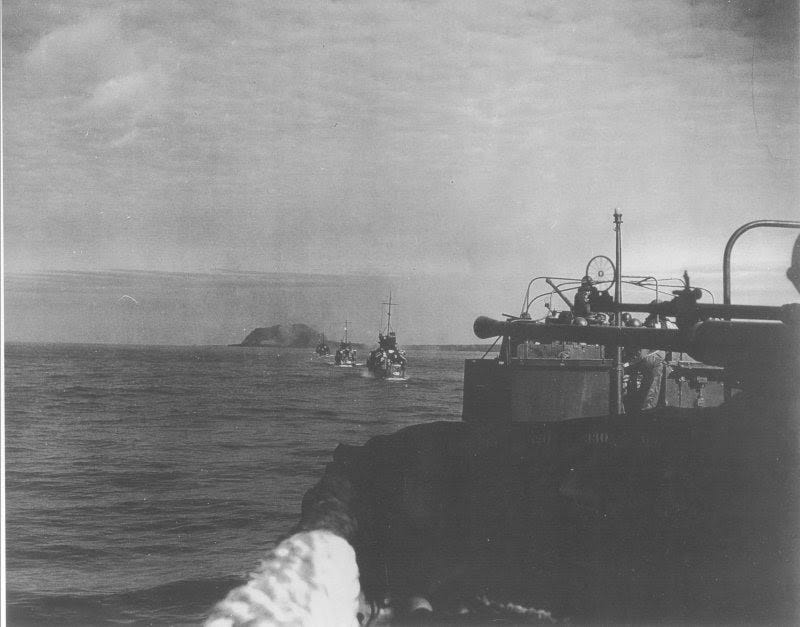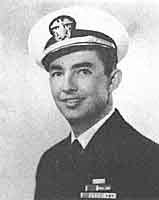In the end, it is all about going in harm's way.
One of the more under told stories of Iwo Jima. When there is talk about not leaving a man behind, when you hear talk about closing with the enemy, when people are ordered to support a mission, this is what they are talking about.Ships and men like those on LCI(G)-449 under the command of LTjg Rufus Herring, USNR. 229' long, max speed of 16 kts. No armor. A set of orders. Cover the UDT teams.
It starts like this.
The four UDT’s were embarked in the destroyer transports (APD’s) Barr, Bates, Bull, and Blessman. At a
distance of 500 yards of the beach, the UDT’s would make their plunge. The seven aforementioned LCI (G)’s firing their 20mm and 40mm guns at the beaches and preparing to launch their 4.5” rockets followed them. Soon after these gunboats passed the 1,500-yard line, mortar shells began falling among them; a little later, as they were beginning to launch rockets, they came under intense fire from the flanks of the beaches.
-------------
Deck Log, LCI Group 8, Flotilla 3 at Iwo Jima:
1000-In line abreast, LCI (G)’s 457 (FF), 441, 449, 438, 474, 450 and 473 approached base of Mt. Suribachi on course 325T, distance 500 yards, speed 9 knots.
1055-Hit simultaneously were LCI (G)’s 474, 450 and 473
-------------
Between 1055 and 1105 the seven LCI (G)’s advancing in line abreast began to take hits but pressed on to support the swimmers until forced out by damage and casualties. The reserve and unassigned Group 8 LCI(G)s 346, 348, 466, 469 and 471 dashed in to replace them, only to be hit in turn time after time.
- LCI (G)’s 438, 441, 471 and several others, although hit several times, gallantly returned to the fray after retiring from it just long enough to extinguish their fires and plug holes in their hulls.
All twelve of Group 8’s LCI (G)’s took part and all were hit, but the stuck to it until the swimmers of the UDT’s were recovered and clear. During this engagement LCI (G) 474 was abandoned and sunk after sustaining heavy damage and casualties.
As was said of the LCI (G)’s: “Their courage and persistence inspired everyone who watched these vessels.”
Of all these grand Sailors, one ship and one man stands out. That says a lot. Almost a sublime deck log.
Deck Log, USS LCI (G) 449:
1058 – Received shell of undetermined size on the bow aft of the 40mm splinter shield with the resulting casualties: Two men killed, two men
missing, both were blown off of the bow; and three men wounded.
1103 - Received shell of undetermined size on the port side 40 mm with casualties unknown.
1104 – Received a shell of undetermined size on the starboard side of the conning tower with unknown number of casualties.
1130 – Hove to on port side of DMS while they sent a small boat with one doctor and several corpsmen l to give medical assistance.
1135 – Got underway at one-third speed proceeding to the port quarter of the USS Terror (CM-5).
1200 – 1600 – Moored to the port quarter of the USS Terror (CM-5) at which time several doctors and corpsmen came aboard to assist in transferring the injured and dead aboard that ship.
1530 - Cast off from Terror various courses and speeds proceeding to the northeast end of Iowa Jima. A check found that twenty men were killed and eight were wounded including the Captain, LT (jg) Rufus Geddie Herring.
J. J. Mittleman, LTJG, USNR Navigator
LTjg Herring received the Medal of Honor that day. LTjg Mittleman the Silver Star.
Herring’s citation reads.
For conspicuous gallantry and intrepidity at the risk of his life above and beyond the call of duty as commanding officer of LCI (G) 449 operating as a unit of LCI (G) Group 8, during the preinvasion attack on Iwo Jima on 17 February 1945. Boldly closing the strongly fortified shores under the devastating fire of Japanese coastal defense guns, Lt. (then Lt. (j.g.)) Herring directed shattering barrages of 40mm. and 20mm. gunfire against hostile beaches until struck down by the enemy's savage counterfire which blasted the 449's heavy guns and whipped her decks into sheets of flame. Regaining consciousness despite profuse bleeding he was again critically wounded when a Japanese mortar crashed the conning station, instantly killing or fatally wounding most of the officers and leaving the ship wallowing without navigational control. Upon recovering the second time, Lt. Herring resolutely climbed down to the pilothouse and, fighting against his rapidly waning strength, took over the helm, established communication with the engineroom, and carried on valiantly until relief could be obtained. When no longer able to stand, he propped himself against empty shell cases and rallied his men to the aid of the wounded; he maintained position in the firing line with his 20mm. guns in action in the face of sustained enemy fire, and conned his crippled ship to safety. His unwavering fortitude, aggressive perseverance, and indomitable spirit against terrific odds reflect the highest credit upon Lt. Herring and uphold the highest traditions of the U.S. Naval Service.
Fullbore.







FULL BORE Squared. Had the fortune to go to Iwo 15 times while at Atsugi. The most memorable were the trips where we'd take the USMC from Iwakuni and Oki out for a 3 day battlefield studies group tour. We'd raise the flags/render honors, walk the battleground, hit the gun pits and look at the beaches, and read from the history books. If you've never been you can't understand the sucking black volcanic sand, or how close the LCIs and landing craft were to Suribachi, or the slope of the beach that went from 20 ft deep water to land in less than 8 lateral feet. Marines would jump out and go straight to the bottom even tho the front of the landing craft was ashore. It is, and always will be, hallowed ground. I have a tall glass jar filled with volcanic sand and spent ordnance on my desk.
The only downside was inspecting the Marines before boarding the a/c, as everyone wanted to bring back souvenirs like Japanese bullet clips, or US 50 cal rounds, or worse - like the time I found an antitank round in a backpack. EEE OOOO DDDD!!!!! The Japanese were still finding casualties in the tunnels, and we'd attend the funeral service on the ramp before they were flown back to Japan to be interred at the Yasakuni shrine.
Once you go, you will never look at the USMC the same ever again. My last trip we raised one American flag, took photos of the raising, the salutes, the date/time, and those in attendance. but this flag was special, as it was for a senior USMC officer who had fought on Iwo as an enlisted, and was now dying with cancer. He wanted that flag for his coffin and funeral. Not a dry eye in the photo. They went to hell and back for sure.
FullBore!
For the last 20 years I have kept a copy of "The Book" in every office I have occupied in government.
"The Book", as I call it, is the full listing and citation of every Medal of Honor recipient in the history of the Medal.
It's about 2" thick.
Whenever I get frustrated with a mission or task, or start to feel demoralized, I pick it up, flip it open to a random page, and read the citation.
When I need particular motivation, I tend to flip to the sections for WW2, and look for USMC citations.
(Marines are a stingy lot, and we tend not to give out the Medal until long after most other services would have determined it was warranted. As a result, most Marine citations read like a page from a superman novel)
I frequently offer it as suggested reading to others who come to me with problems and no ideas for solutions, or who clearly don't have the intestinal fortitude for a proverbial battle with a contracting officer, much less a determined adversary who would kill them.
My hat is off to LtJg Herring and his brave crew. Bravo Zulu!